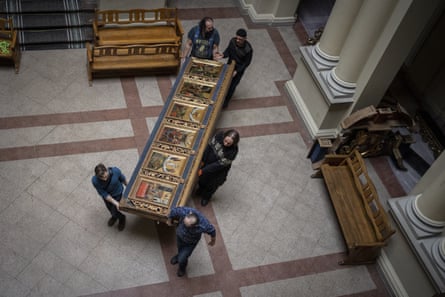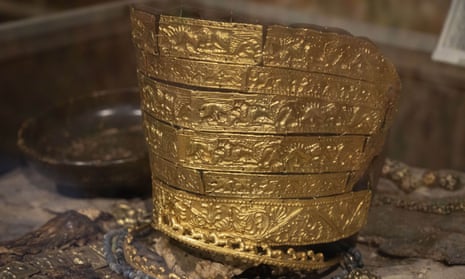The people the Greeks called Scythians were formidable warriors and nomads who dominated the Eurasian steppe for more than 1,000 years from about 800BC – long before the creation of national borders.
The fabulous gold weapons and ornaments they left behind ended up in museums across the region, many of them in Ukraine. Since Russian troops invaded Ukraine in February, however, much Scythian gold – along with millions of other priceless artefacts – has been looted or “evacuated”.
Serhii Telizhenko, of the National Institute of Archaeology in Kyiv, who has been monitoring the wave of destruction, said he realised there would be losses after the invasion, “but I could not imagine the scale”.

Some museums managed to move their collections to safety in time. They include Odesa’s archaeological museum and one in Melitopol that holds Ukraine’s most important collection of Scythian gold. Meanwhile Irina Shramko, director of Kharkiv’s archaeological museum, and her colleagues have been spending their nights close to their Scythian and bronze age treasures.
“This is the case all over Ukraine,” said Regina Uhl of the German Archaeological Institute in Berlin, which has been providing money and materials for its Ukrainian colleagues. “They thought they could protect the objects better if they were closer.”
However the rapidity of the Russian occupation in the east of the country, especially, meant many museums had no time to implement their evacuation plans. Local history museums in Lyman, in the Donetsk region, and Rubizhne in Luhansk had been destroyed, Telizhenko said, and the fate of their collections was unknown.
The museum of local lore in Mariupol, which also had an important collection of Scythian gold, was badly shelled in the spring, and in April Russian media announced that about 2,000 objects had been removed from it to the occupied city of Donetsk. They include priceless paintings by Arkhip Kuindzhi and Ivan Aivazovsky.

Ukrainian intelligence claims that much of the material taken from its museums has found its way to Crimea. Telizhenko cited reports that in late October, employees of the Chersonese state museum in Sevastopol, Crimea, arrived at the Kherson regional museum of local lore to remove its collection.
While this report is hard to confirm, it is corroborated by sources in the country as well as exchanges in virtual forums being monitored from outside Ukraine. Much of the destruction and removal of objects has been documented photographically, and the photos published on a website set up by the Ukrainian government to record “culture crimes”.

The website includes images of damaged archaeological sites. Telizhenko said that some of the destruction predated the current conflict. Russian troops began building defensive structures on a cluster of bronze age burial mounds near the village in Dovhe in the Luhansk region in 2017, he said. “The integrity of this complex is lost forever,” he said of the 5,000-year-old site. “There are many such cases, because the warring parties use the features of the terrain for self-defence.”
Archaeologist Mykhailo Videiko of Borys Grinchenko Kyiv University confirmed this: “They dig in for defence, often in places where people did the same hundreds and thousands of years ago.” He noted that ramparts up to nine metres high, built by the princes of Kyiv in the 10th century to repel eastern marauders, successfully repelled Russian tanks more than 12 centuries later.
Sam Hardy, head of illicit trade research at international charity the Heritage Management Organisation, said the loss of ancient sites’ integrity was more serious than the loss of priceless artefacts. “The thing that we get the information from is the context, the relationship between everything, the site rather than the individual object,” he said.
Hardy said that there had been organised removal efforts by the Russians in territories they had occupied, and looting by Ukrainians and Russians – though mostly by Russians. “There’s a huge problem of legal nihilism in both societies,” he says. “People don’t really feel that the law exists or is implemented fairly.”
His monitoring of Russian media and internet channels indicates that some collections removed to Crimea have already been moved on, further into Russia. Meanwhile, Russian looters are targeting Crimean sites that they perceive to be of high value for antiquities, including Unesco world heritage sites.
It was similar to the aftermath of the second world war, said Friederike Fless, president of the German Archaeological Institute, when the Red Army’s so-called trophy brigades stripped eastern German, Ukrainian and other museums. Among the collections spirited out of Berlin were Priam’s treasure, the cache of priceless objects from Troy unearthed by German archaeologist Heinrich Schliemann in the 1870s.
Although the overall picture looks bleak for Ukraine, Videiko said there was a silver lining. The disturbance of ancient sites had brought to light new finds, including a previously unknown site of the mysterious Trypillians – one of the last surviving cultures of Neolithic Europe. When the electricity supply permits, he and his colleagues hunker down to write up those finds. “This year has been very fruitful from a scientific point of view,” he said.
